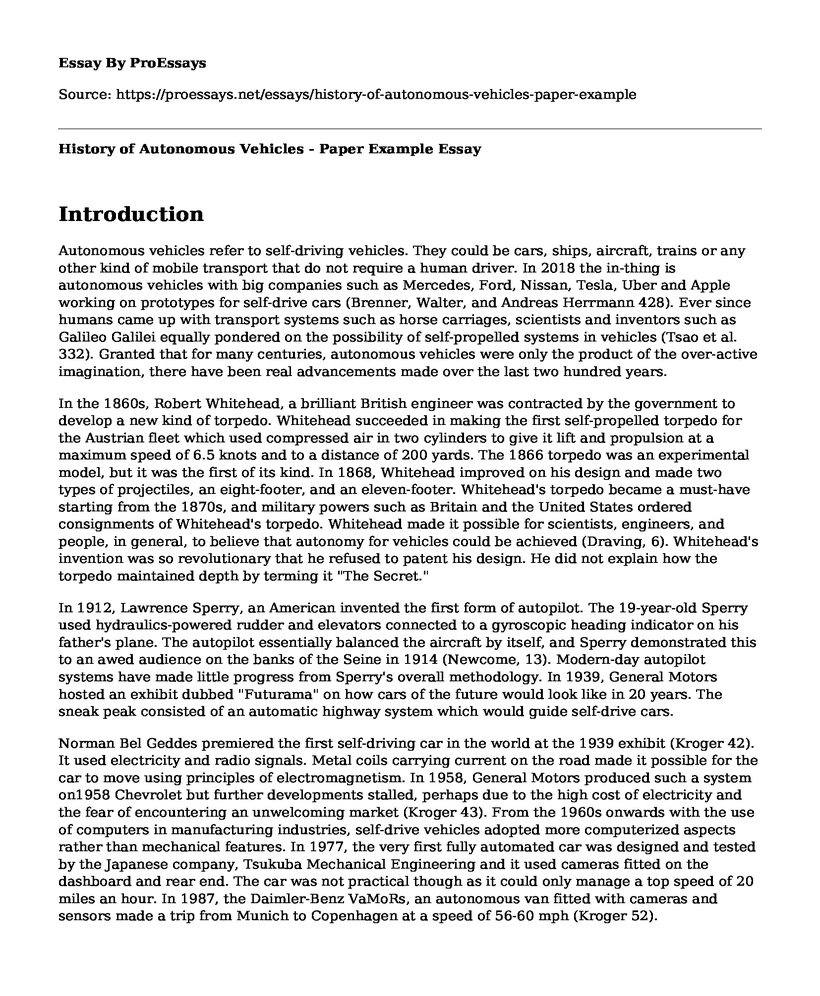Introduction
Autonomous vehicles refer to self-driving vehicles. They could be cars, ships, aircraft, trains or any other kind of mobile transport that do not require a human driver. In 2018 the in-thing is autonomous vehicles with big companies such as Mercedes, Ford, Nissan, Tesla, Uber and Apple working on prototypes for self-drive cars (Brenner, Walter, and Andreas Herrmann 428). Ever since humans came up with transport systems such as horse carriages, scientists and inventors such as Galileo Galilei equally pondered on the possibility of self-propelled systems in vehicles (Tsao et al. 332). Granted that for many centuries, autonomous vehicles were only the product of the over-active imagination, there have been real advancements made over the last two hundred years.
In the 1860s, Robert Whitehead, a brilliant British engineer was contracted by the government to develop a new kind of torpedo. Whitehead succeeded in making the first self-propelled torpedo for the Austrian fleet which used compressed air in two cylinders to give it lift and propulsion at a maximum speed of 6.5 knots and to a distance of 200 yards. The 1866 torpedo was an experimental model, but it was the first of its kind. In 1868, Whitehead improved on his design and made two types of projectiles, an eight-footer, and an eleven-footer. Whitehead's torpedo became a must-have starting from the 1870s, and military powers such as Britain and the United States ordered consignments of Whitehead's torpedo. Whitehead made it possible for scientists, engineers, and people, in general, to believe that autonomy for vehicles could be achieved (Draving, 6). Whitehead's invention was so revolutionary that he refused to patent his design. He did not explain how the torpedo maintained depth by terming it "The Secret."
In 1912, Lawrence Sperry, an American invented the first form of autopilot. The 19-year-old Sperry used hydraulics-powered rudder and elevators connected to a gyroscopic heading indicator on his father's plane. The autopilot essentially balanced the aircraft by itself, and Sperry demonstrated this to an awed audience on the banks of the Seine in 1914 (Newcome, 13). Modern-day autopilot systems have made little progress from Sperry's overall methodology. In 1939, General Motors hosted an exhibit dubbed "Futurama" on how cars of the future would look like in 20 years. The sneak peak consisted of an automatic highway system which would guide self-drive cars.
Norman Bel Geddes premiered the first self-driving car in the world at the 1939 exhibit (Kroger 42). It used electricity and radio signals. Metal coils carrying current on the road made it possible for the car to move using principles of electromagnetism. In 1958, General Motors produced such a system on1958 Chevrolet but further developments stalled, perhaps due to the high cost of electricity and the fear of encountering an unwelcoming market (Kroger 43). From the 1960s onwards with the use of computers in manufacturing industries, self-drive vehicles adopted more computerized aspects rather than mechanical features. In 1977, the very first fully automated car was designed and tested by the Japanese company, Tsukuba Mechanical Engineering and it used cameras fitted on the dashboard and rear end. The car was not practical though as it could only manage a top speed of 20 miles an hour. In 1987, the Daimler-Benz VaMoRs, an autonomous van fitted with cameras and sensors made a trip from Munich to Copenhagen at a speed of 56-60 mph (Kroger 52).
In 2009, Google joined in the autonomous-car sector and in 2014 the company showcased a self-driving car with neither a gas and brake pedal nor a steering wheel, hence a fully automated vehicle (Sperling 23). In 2018, NVIDIA, the computer parts manufacturer announced partnering with Volkswagen to produce an Artificial Intelligence autonomous car. Nissan has set the date that it will create a fully self-driving car by 2020. Tesla announced in August 2018 that it was working on its computer chip for autonomous vehicles. Every year since the 2010s, big names in technology and car manufacturing are splashing millions and billions of dollars into developing fully autonomous cars (Sperling 1). The dream of fully self-driving cars is only a matter of time.
Works Cited
Brenner, Walter, and Andreas Herrmann. "An overview of technology, benefits, and impact of automated and autonomous driving on the automotive industry." Digital Marketplaces Unleashed. Springer, Berlin, Heidelberg, 2018. 427-442.
Draving, Wolfgang. Living in the Drone Age: What is the impact of military unmanned vehicles on the global sociopolitical structure? Diss. 2018.
Kroger, Fabian. "Automated driving in its social, historical and cultural contexts." Autonomous Driving. Springer, Berlin, Heidelberg, 2016. 41-68.
Newcome, Laurence R. Unmanned aviation: a brief history of unmanned aerial vehicles. American Institute of Aeronautics and Astronautics, 2004.
Sperling, Daniel. Three Revolutions: Steering Automated, Shared, and Electric Vehicles to a Better Future. Island Press, 2018.
Tsao, J. Y., et al. "Galileo's stream: A framework for understanding knowledge production." Research Policy 37.2 (2008): 330-352.
Cite this page
History of Autonomous Vehicles - Paper Example. (2022, Jul 25). Retrieved from https://proessays.net/essays/history-of-autonomous-vehicles-paper-example
If you are the original author of this essay and no longer wish to have it published on the ProEssays website, please click below to request its removal:
- Technology Essay Example: Solar Panels
- Mobile Phone Forensics - Example of Writing Assignment
- Research Proposal on Impact of Artificial Intelligence on Audit Firms
- Essay Sample on Internet Privacy: A Growing Global Concern?
- Technology & Energy: Historical Evolution & Social Impact - Essay Sample
- Developing West: Gains and Glitches in Global GDP - Essay Sample
- Meaning of Cell Phones - Free Report Sample







